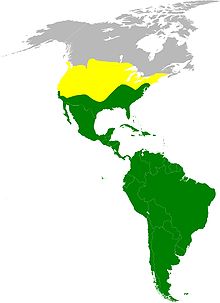New World vulture
| New World vultures Temporal range: Eocene to Holocene |
|
|---|---|
 |
|
| Turkey vulture | |
| Scientific classification | |
| Kingdom: | Animalia |
| Phylum: | Chordata |
| Class: | Aves |
| Order: | Cathartiformes |
| Family: |
Cathartidae Lafresnaye, 1839 |
| Genera | |
 |
|
|
Approximate Cathartidae range map Yellow – Summer-only range of turkey vulture |
|
Coragyps
Cathartes
Gymnogyps
Vultur
Sarcoramphus
Yellow – Summer-only range of turkey vulture
Green – At least one species present year-round
The New World vulture or condor family Cathartidae contains seven species in five genera, all but one of which are monotypic. It includes five vultures and two condors found in warm and temperate areas of the Americas. The "New World" vultures were widespread in both the Old World and North America during the Neogene.
New World vultures do not form a monophyletic clade with the superficially similar family of Old World vultures, but similarities between the two groups are due to convergent evolution. Many now consider them to be in their own order Cathartiformes, closely related to, but distinct from, Old World vultures and allies (Accipitriformes).
Vultures are scavenging birds, feeding mostly from of dead animals without apparent ill effects. Bacteria in the food source, pathogenic to other vertebrates, dominate the vulture’s gut flora, and vultures benefit from the bacterial breakdown of carrion tissue. New World vultures have a good sense of smell, whereas Old World vultures find carcasses exclusively by sight. A particular characteristic of many vultures is a bald head, devoid of feathers.
...
Wikipedia
